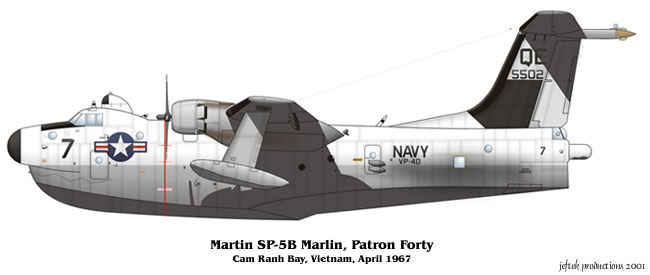|
|

 Patrol Squadron FORTY (VP-40) was established at NAS San Diego, Calif. as a seaplane squadron flying the Mariner PBM-5 on 20 January 1951. This was the second squadron to be assigned the VP-40 designation. The squadron conducted its first operational deployment to MCAS Iwakuni, Japan during 15 May-12 Dec 1951. Part of VP-40's complement of aircraft had been augmented prior to deployment with new PBM-5S aircraft. The squadron's first combat patrols during the Korean War were flown on 9 June 1951. Over the next six months VP-40 patrolled the Tsushima Straits, flew cover for replenishment groups in the Yellow Sea and Sea of Japan and made weather reconnaissance flights for the fleet forces. On 2 Sep 1952 VP-40 deployed to NS Sangley Point, Philippines, with operations conducted from Okinawa and the Pescadores Islands patrolling the Formosa Straits. VP-40 returned to NAS San Diego in April and began refitting with the new P5M-1 Marlin seaplane. These were later replaced by the newer P5M-2 in 1957. Six VP-40 P5M-2 seaplanes landed at Bangkok, Thailand on 1 Jul 1958, the first occasion on which any U.S. seaplane squadron had visited the city. The squadron home port was changed from NAS San Diego, Calif., to NS Sangley Point, Philippines, on 1 Jul 1958 becoming the first permanently based seaplane patrol squadron in the Pacific. During the deployment the squadron adopted the motto "Laging Handa," Tagalog for "always ready." Tragedy struck On 2 Aug 1962 when VP-40 commanding officer, Commander N. P. Vegelan, and 11 of his crew were killed after QE-1 crashed into the side of a mountain. In March 1964 VP-40's home port was once again back to NAS North Island, San Diego, Calif. resuming Six month deployments for WestPac patrol squadrons. The Fighting Marlins deployed to NS Sangley Point, relieving VP-47 on 27 Feb 1965. During the deployment the squadron received tender support from Salisbury Sound (AV 13) and Currituck (AV 7), while conducting operations from remote sites at Ko Samui, Thailand; Con Son Islands; and DaNang, South Vietnam. Throughout 1965-1967 VP-40 deployed to NS Sangley Point, Philippines, with detachments at various locations throughout WestPac tended by Salisbury Sound (AV 13). Finally in March 1967, Seaplane tender Currituck (AV 7) participated in the last official tender operation in a combat zone with the Navy while supporting VP-40 operations. During the Vietnam conflict VP-40 had rotated assignments with VP-50 out of NS Sangley Point, Philippines, and Cam Ranh Bay, South Vietnam, supported by tenders Currituck (AV 7), Salisbury Sound (AV 13) and Pine Island (AV 12). This was also the last deployment for VP-40 as a seaplane squadron, with the last patrol flight in a squadron SP-5B over the South China Sea taking place on 17 May 1967. Later that month, the NS Sangley Point seadrome was closed and all remaining SP-5B aircraft were flown to Konan, Japan, where they were dismantled for scrap. The last flight of a SP-5B took place on 15 Nov 1967, marking the move of the squadron from NAS San Diego to NAS Moffett Field, and the squadrons transition to the land-based P-3B Lockheed Orion. The ceremonial flight closed an era of Navy seaplane operations that had begun in 1911. The last SP-5B Marlin was flown from NAS San Diego, Calif., to NAS Patuxent River, Md. In 12 Jul 1968, for addition to the historic aircraft preservation program of the National Air and Space Museum, Smithsonian Institution. After several years of storage the aircraft was barged to NAS Pensacola and is now on display at the National Museum of Naval Aviation. On 1 Feb 1969 the Fighting Marlins made their first deployment in theP-3B to MCAS Iwakuni, Japan. |